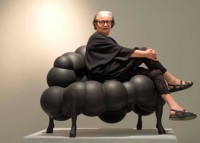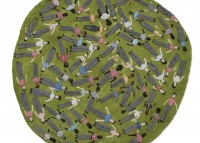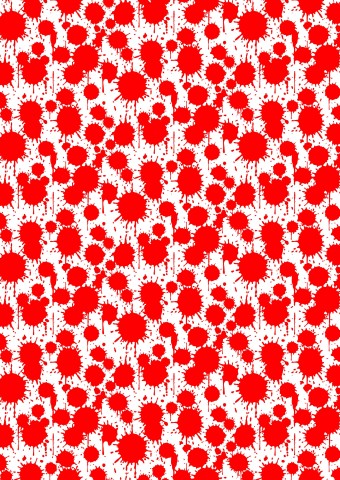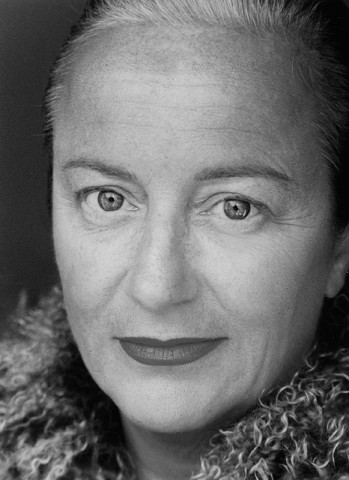“I don’t know who discovered water, but I’m pretty sure it wasn’t a fish.” ~ Marshall McLuhan (1911-1980), Media critic & writer
“I don’t know who discovered water,
but I’m pretty sure it wasn’t a fish.”~ Marshall McLuhan (1911-1980),
Media critic & writer
For over twenty years, I believed that the author of this statement was Spanish/American philosopher George Santanyana. I now discover it was penned by the redoubtable Canadian media critic, Marshall McLuhan. I’ve also seen it attributed to others. Whatever its source, like all good metaphors it makes you think, and I’ve been thinking lately about what it takes to swim beyond the pool. For me, there are three defining characteristics:
- thinking outside pre-existing categories
- seeking different pathways for creative expression, and often inventing new ones
- showing resilience over time – Sisu.
To explore these characteristics, Project Sisu launches a new series dedicated to unconventional fish, starting with Dutch born futurist, Lidewij Edelkoort.
Lidewij Edelkoort was born in Wageningen, Holland in 1950. After completing her studies in fashion design at the School of Fine Arts in Arnhem, she became a trend forecaster for the Dutch department store, De Bijenkorf. While there she honed her talent for intuiting trends and constructing a language through which she could describe what she saw to others. Based in Paris since 1975, Edelkoort has since seeded a constellation of global design and curatorial hubs called Trend Union and Studio Edelkoort, which produce annual trend forecasts and consult with a range of businesses and industry groups. In 1998, she launched a biannual magazine called Bloom, described by Dutch FA as a ‘horticultural bookazine’, along with other publications such as View on Colour (1992) and interior design magazine, InView. In addition to trend forecasting, publishing, writing and consulting, Edelkoort has also curated a number of exhibitions, including Post Fossil: Excavating 21st Century Creation in 2010, at the invitation of Japanese fashion designer, Issey Miyake, and Talking Textiles, first shown in Milan during the Salone del Mobile 2011.

Edelkoort with Post Fossil exhibit
Edelkoort’s three decades or more of creative thought leadership have won her various medals, accolades and acknowledgements. In 1995, Aid to Artisans honoured her with a Lifetime Achievement Award for her continual support of craft and design. Heartwear, a non-profit organisation she co-founded in 1993 to promote the production of artisan crafts from Morocco, Benin, South Africa and India, was the obvious focus of such an award. In 2003, TIME magazine named her one of the world’s 25 most influential people in fashion. In 2004, she was awarded the Netherlands’ Grand Seigneur prize for her work in fashion and textile. In 2008, she was awarded the Chevalier de l’Ordre des Arts et des Lettres by the French Ministry of Culture and Communication. And in 2012, she won the Netherlands’ Prins Bernhard Cultuurfonds prize, given annually to a celebrity in the cultural field.
In 2011, Edelkoort launched an online “wikipedia of trends” called Trend Tablet. With it’s lush photographic juxtapositions and eclectic subject range, Trend Tablet provides a constant source of visual stimulation and unexpected assemblage. On its first birthday, Edelkoort wrote that her dream for Trend Tablet has been to provide a space: “where we would create joint moodboards with the images that haunt us, and where we would create common colourcards on directions that stir emotions in others. .….a collective universal observatorium of trends and talents; where anybody can post his or her idea and where anybody can find inspiration.” Few online web experiences have achieved such tactile beauty, so it appears that her dream is being realised.
shaking things up

Circus Rug (2010) by Fernand, Talking Texiles
Using what she calls trained intuition, Edelkoort’s gift is to interpret signs, signals and tensions that presage future human needs. The trust she exhibits in this and the colour she brings to its expression, mark her out in a landscape sodden with dehydrated imagery and banal corporatised text. The interpretation of perceptions, feelings and body experiences (right hemisphere, internal world) into an integrative language that yields foresight (left hemisphere), requires both metaphorical thinking and deductive logic, or, what Edelkoort calls, reason not whim. Intense observational techniques, combined with a talent for pattern recognition, lie at the heart of strategic foresight, and it seems that Edelkoort has elevated this process into an art form. A decade ago, she predicted that the increasing virtuality of our lives would propel us to seek greater tactility. Consolidating this insight with talk of a ‘romantic revival’, she now notes: “After a reaction to the increasingly digital landscape of our lives, a craving for tactility and dimension has led several designers to reconsider the role of fabrics once more. The near future will see the overwhelming return of textiles in our interiors, covering floors, walls and furniture in an expansive and personal manner. These textiles will speak loud and clear and become the fabrics of life, narrating stories, designing pattern, promoting well-being and reviving the act of weaving.” (Talking Textiles)
“The best way to describe it is that I’m doing archaeology of the future,” she says. “I pick up fragments I see here or there—one brief image of a little girl, one photograph of an avant-garde artist, one video, one discussion, one observation. There are several leads, and then on top is my intuition, which tells me my eye is glued to this picture for a reason, and that it’s going to materialize into something important.” Li Edelkoort, Metropolis
In addition to textile and handcraft revival, Edelkoort predicts that the age of individualism is over. New forms of global governance will replace national ones, especially when it comes to big, long-term planning issues. “The whole system needs a shake up,” she told DLDwomen Magazine; vertical pyramids will give way to the “plateau”, or the “terrace”, where “we will need to lean on each other far more…we’re going back to team-working, to groups, to couples.” Old dualities (gender, race, age) will move aside in favour of “essence and content”; and, like Hegel, she sees a dialectic at work in this interplay of opposites leading to the eventual emergence of something new, an “amalgamation of contrasts.” (Dutch FA, 2011)
Successful societies “will be the ones smart enough to let go of the concept of the individual and instead work as a team.” (DLD Women, 2012) But like all major social change, this transition will be accompanied by pain, possibly another world war. (Dutch FA) As these dark undercurrents swirl throughout our lives, they also give rise to countervailing forces: the need to be cradled, contained, and earthed, hence the craving for textiles and handcrafts; a drive to contribute, to give, to be part of new forms of community; and a need for optimism, embodied in Edelkoort’s current aphorism: “Yellow is the new pink.” Yellow/gold, and the primary optimism it represents, “symbolize immateriality and light – the lightness of being.” (Karcher, 2011)
“Once you are able to read the language of fashion, it helps you very much to understand society. For me, the language of fashion is the best possible tool to do forecasting.” Edelkoort, 2012 (Another Mag)
I’m sure that Edelkoort’s oracular style might infuriate or puzzle more concrete thinkers, and it appears that she has her critics. One blogger cites her cult-like status as over-hyped, and her predictions underwhelming; while another detects a whiff of neo-colonialism behind the ambition to take her educational philosophy to new design schools in the Emirates, South Africa and Poland, a suggestion Edelkoort contests. Nevertheless, many others say that her trend forecasts are reliable. She herself has little doubt about her track record: “I started in the ’80s, and I’ve been good on long-term forecasting,” she told Metropolis in 2010. “I’ve been especially good at pre-seeing the U-turns in society. It’s pretty easy to go from year to year in a reasonable, nice economic climate… What makes it very complicated is that some trends come and don’t go.”
a singular path
Edelkoort has been able to braid together a range of trans-disciplinary interests into a business undertaking that defies reductive boxes. These braids include an understanding of textile scholarship, a keen interest in politics and history, and a firm belief in the importance of design education.
“One needs to know the history of culture at large,” she recently told Donatien Grau of Another Mag. “It’s fundamental to have ideas about textiles in order to be able to understand the flux of volumes….. A little piece of fabric enables you to understand the time we live in: fashion, because of its textile component, has that double power. …if you go back to history, you can understand the time period from knowing the dominant fabric. Like when velvet becomes important: velvet is a double, schizophrenic fabric. It’s very artistic and very solid. All the fabrics have a quality, which is like a character. Fashion is casually using these elements of development.” Elsewhere, she describes textiles as the witness of an age, a pictogram, an anthropological adventure, a perspective which is evident in the neo-primitivism that pervades the Post Fossil Exhibition.
Increasingly outspoken about the nationalistic tenor of European politics (echoed in Australia in our endless debates about immigration policy), where borders are becoming more calcified and less fluid, Edelkoort argues for an extension of the global boundary hopping she sees taking place in the creative elites with whom she works (see video above).
“The changes always start at the creative circles and later spread to the masses,” she declares. The AIDS crisis of the1980s cut deep into the radical creative edge of that era, she notes, leaving a swag of heterosexual men in charge of the creative industries, taking feminism “back to square one” by bringing “the bimbo back.” Perhaps this explains her commitment to mentoring and working with young people via the design academies she has either led or instigated. Edelkoort chaired the renowned Dutch design academy Eindhoven from 1999 to 2008, and was invited to found the School of Form in Poznan, Poland in 2011. At Eindhoven, she sought to build a learning framework that encouraged students to think for themselves, and to question everything. The collaborative behaviour she witnessed at Eindhoven has undoubtedly contributed to some of her recent trend forecasts, such as the emphasis on collaborative teams, the blending of male and female, and the new kind of human that will emerge out of a shift away from traditional gender roles.
After leaving her leadership position at Eindhoven in 2008, it appears the school took on a more conventional pedagogic approach, leading to an exodus of head teachers in early 2012. This elicited an impassioned open letter from Edelkoort, in which she stated that a well-functioning system had been undermined by fear of the future and the kind of social and political pressures that create “a rigid system of control and market forces.” She argues that “an educational system built around people and concerned about people is the best guarantee for overcoming new and difficult times.” In fact, a concern for people, and an understanding that people want to be with/work with/create with other people, is a general principle traversing all disciplines, she asserts.
“The whole future lays in the hands of consumers becoming the curators of their own lives.” (DLDwomen Magazine)
resilience in the air – sisu
Women of Edelkoort’s generation, who have sculpted their own spaces for creative expression (often against monumental odds), and continued to nurture and grow these spaces across their lifespan, embody the intent behind Project Sisu. It strikes me that an antipathy to self satisfaction, to stasis, is a characteristic shared among unconventional fish. Edelkoort, too, exhibits this strain of restless, critical intelligence, something I will return to in later portraits.
Now in her 60s, Edelkoort projects a relaxed, confident and elegant presence. In an interview with Daniel Scheffler in 2012, she reflects on the liberties that were bestowed upon her as a middle child, a time when her quest for independence coincided with the emergence of second wave feminism.
“As a middle child and a black sheep I was let free…. I was an easy child — always in my own universe. Living in my imagination. The most amazing thing my parents ever did was not to send me to pre-school, so until the age of six I was completely free to spend time fantasising and building tents and huts in the summertime. It was the 1950s, so we didn’t have anything to act as references like today. I just had to build castles in the air….”
With her head still defiantly in the clouds, and still living the life of a globetrotting sibyl, Lidewij Edelkoort nevertheless describes herself as curious and disciplined. It’s these two seeming opposites that anchor the dreaming to the delivery: “I am an Iron Lady, and I do what I have to do…if you promise, you must deliver.” (DLDwomen, 2012)
Alongside an annual output that would dent the hubris of a 20-year-old, in Edelkoort’s case this means: a pursuit of the avant-garde, a peripatetic imagination, and a healthy disregard for conventional boxes. Someone who knows how, in other words, to swim beyond the pool.
“Avant-gardist urban birds flock together in sombre and grey interiors, while black birds dabble in the darkest iridescence. Parrot pastels will introduce a flapper revival, roaring towards the twenties of the twenty-first century.
All shades can be contrasted with a basic linen, a lacquered black and a matte gold—to make all our colours sing!”
References
Bates, A (2009) Design Schools Go Global, IconEye, 071
Darkplaneur (2012) The Buzz Phrase, Darketing S03E09
DutchFA (2011) Dutch Profiles: Li Edelkoort, 392
Edelkoort, L. (2011) Lidewij Edelkoort for Alcro designers 2011-2012, Trend Tablet Birds
Grau, D. (2012) An Interview with Lidewij Edelkoort, AnOther Magazine
Karcher, E. (2011) Yellow is the new pink – an interview with Li Edelkoort, DLDWomen
Liddell, C.B. (2010) Prophet Motive, Metropolis, Issue 843
Manson, H. (2010) Design Indaba – Of most Extra-ordinary Design, bizcommunity, March 1, 2010
Scheffler, D. (2012) Once Upon a Time with Lidewij Edelkoort, VISI
Schocken, D. (2012) The Age of Doubt, DLDWomen Magazine, No. 10
Note: All websites accessed during August, 2012





